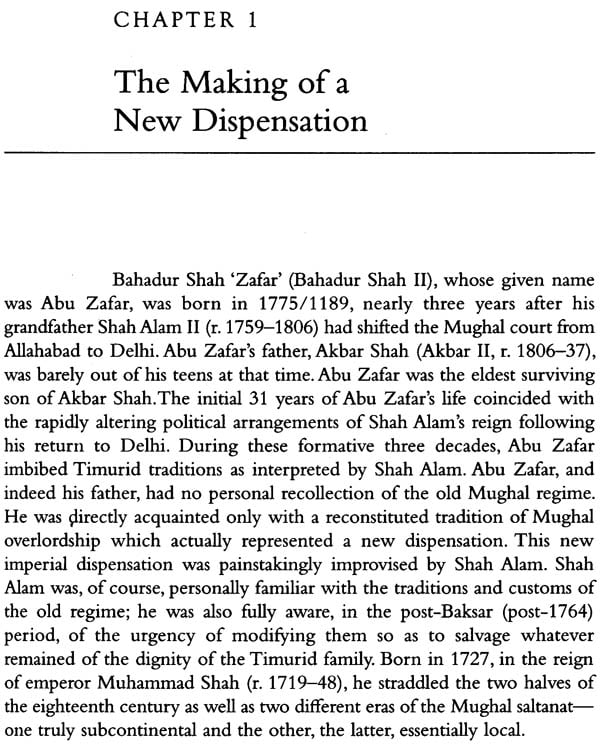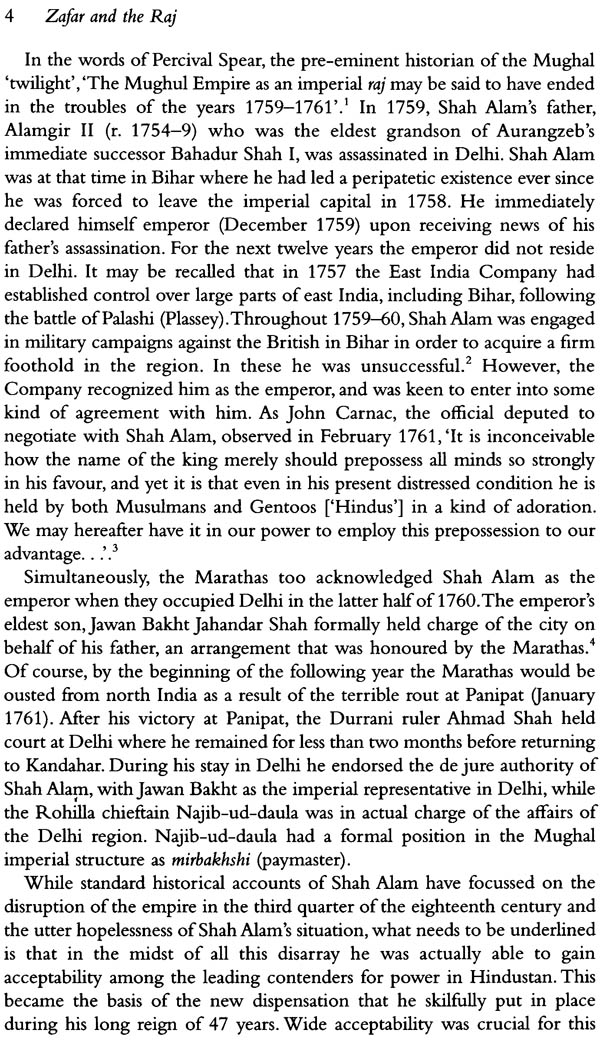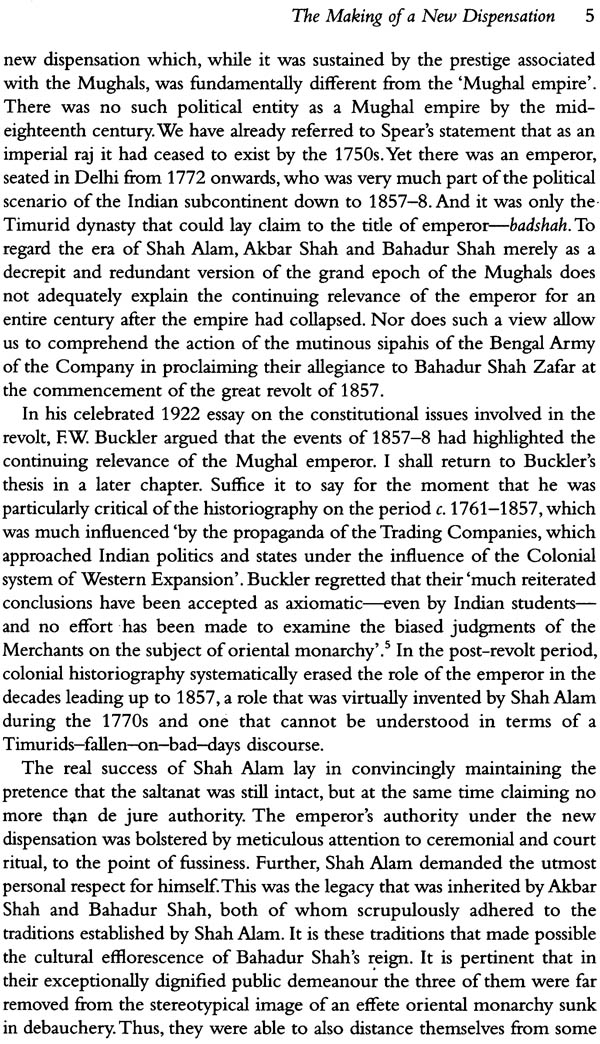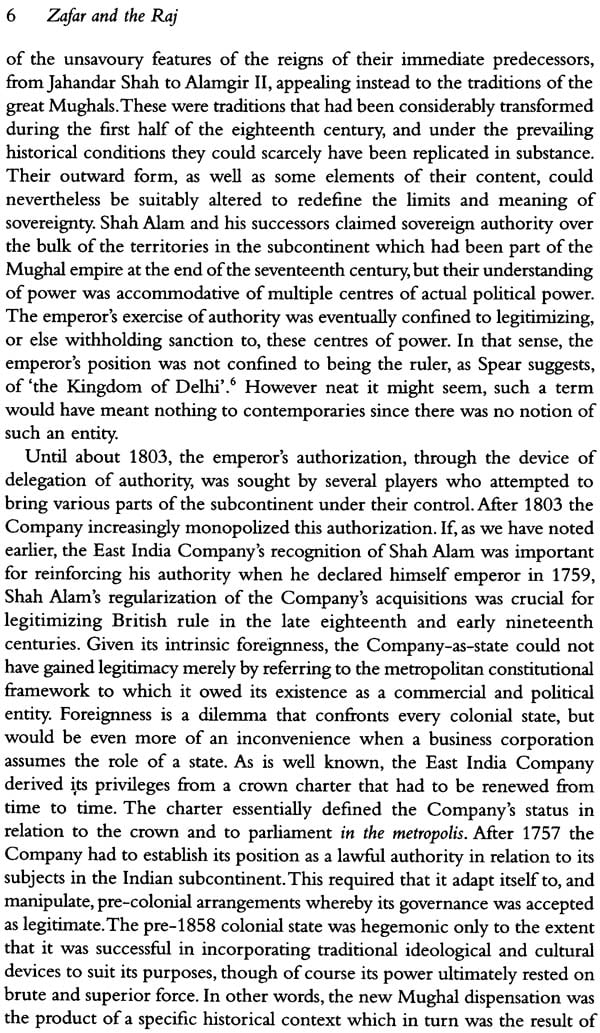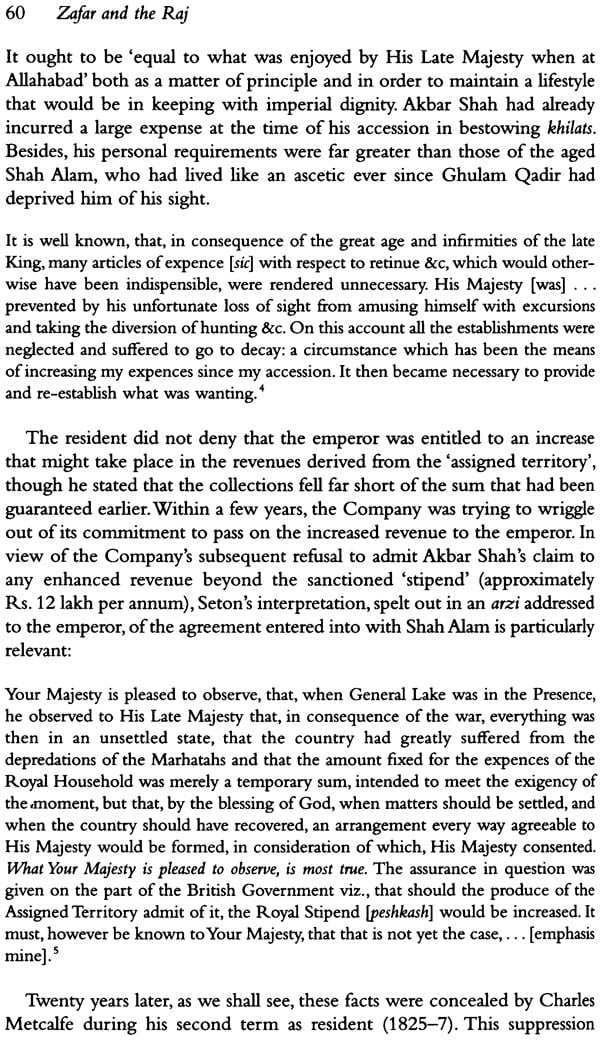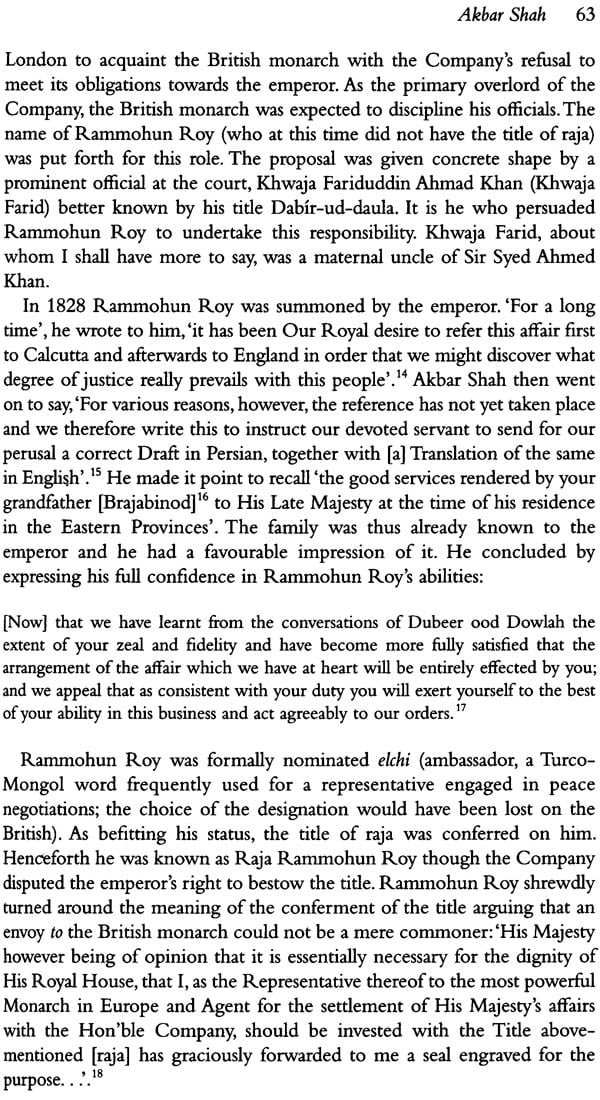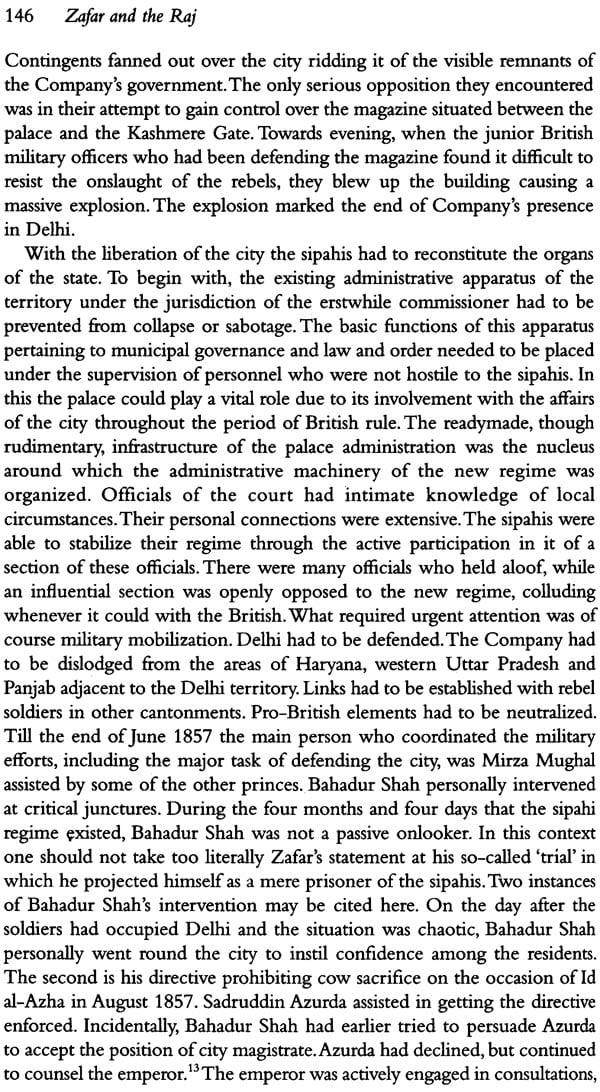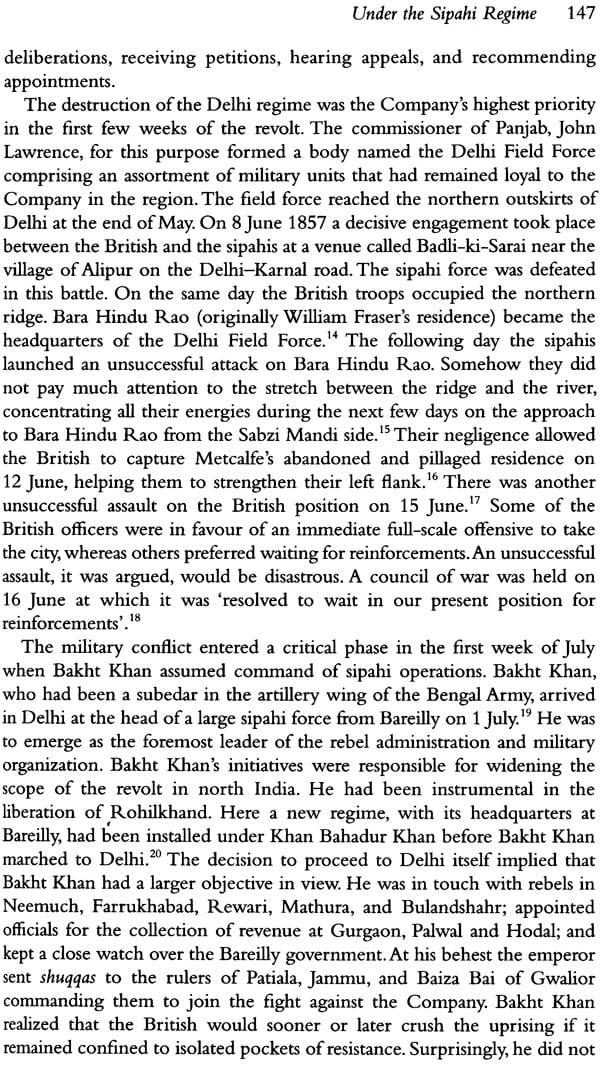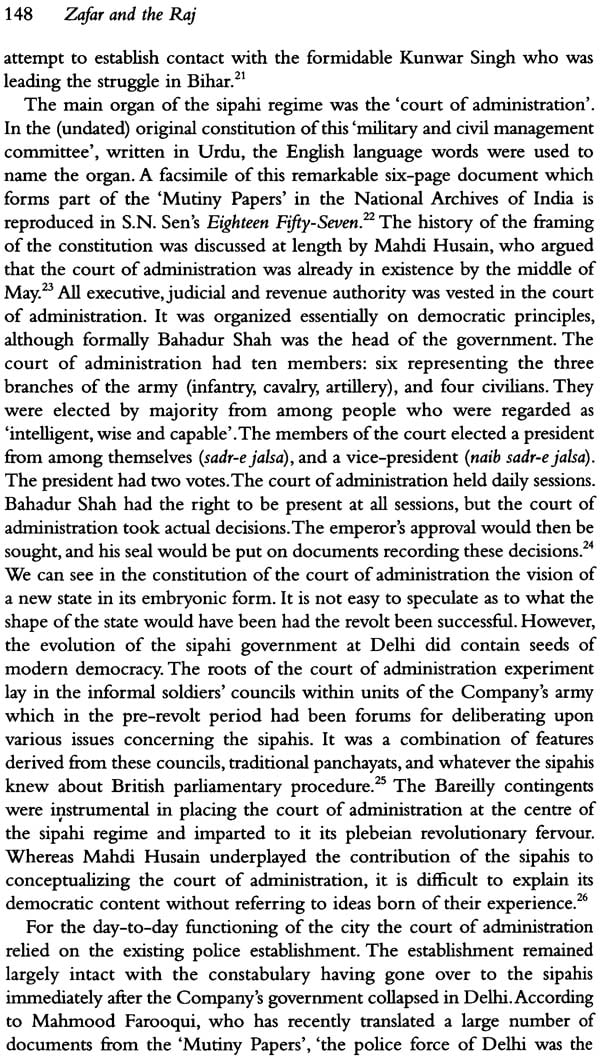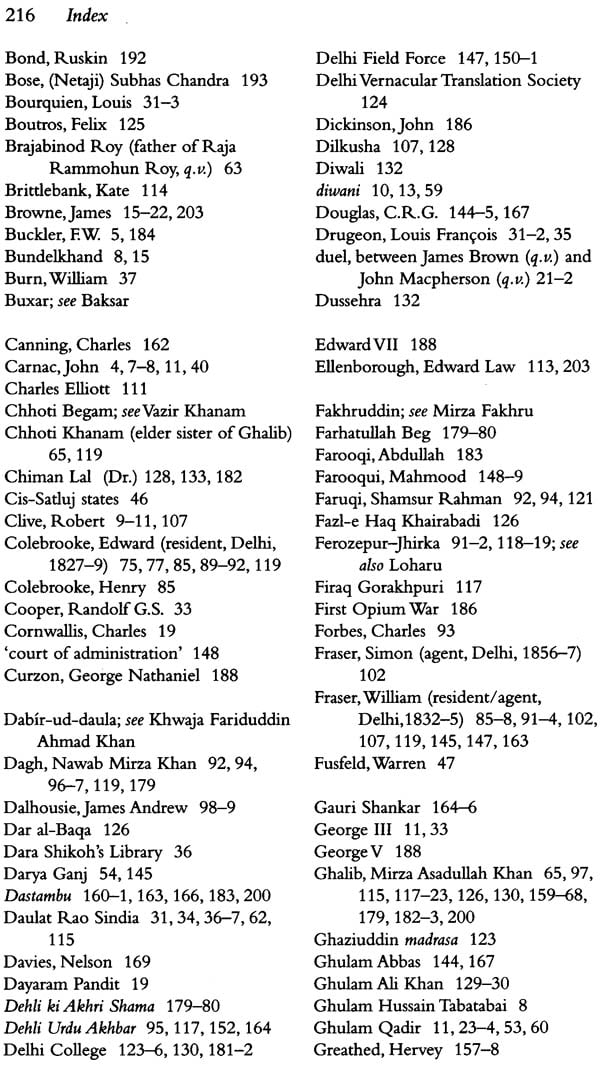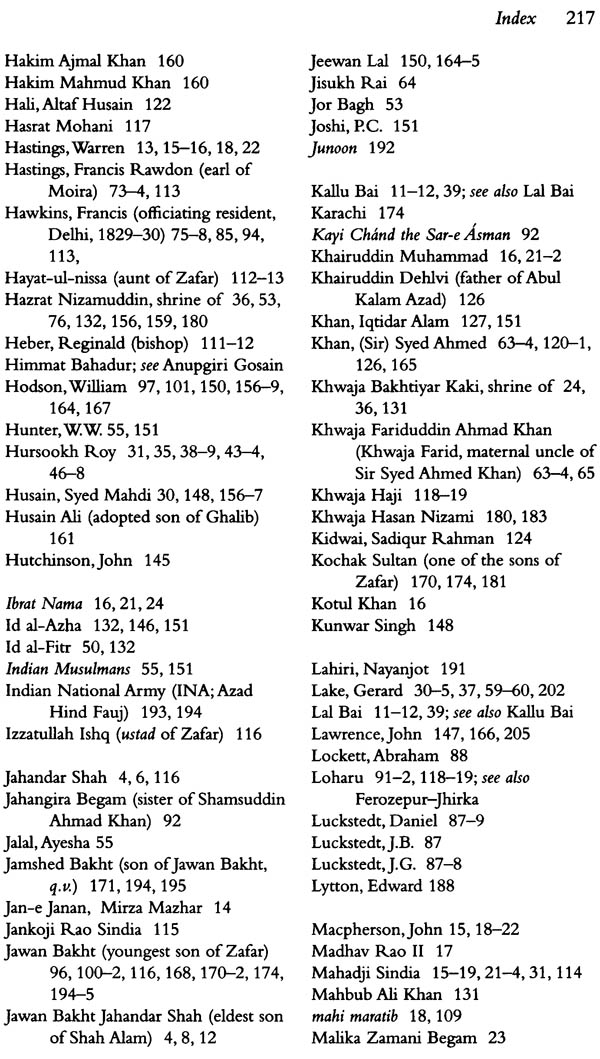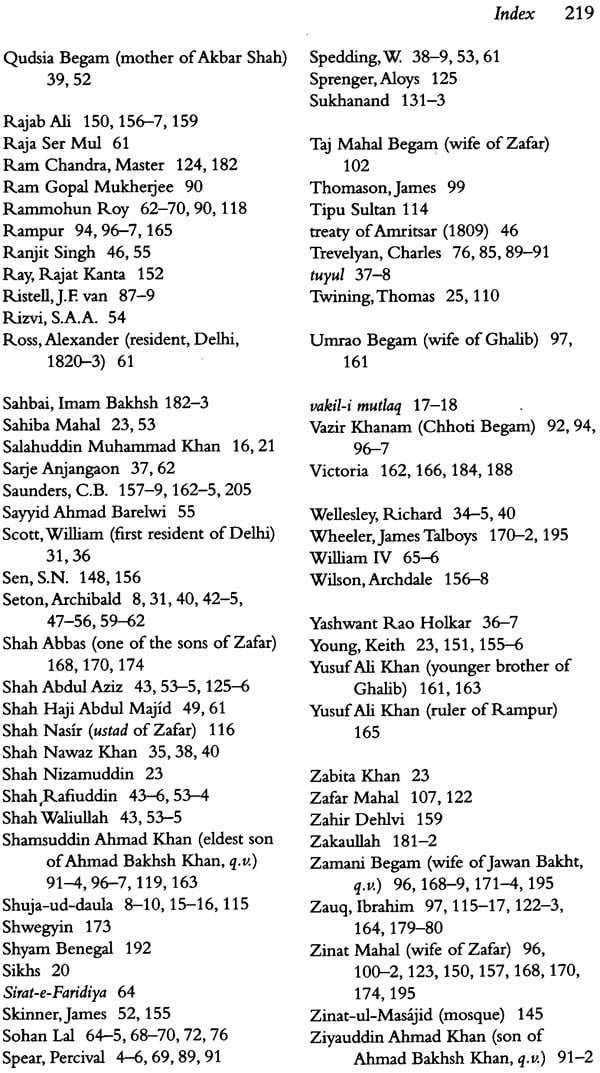
Zafar and The Raj (Anglo- Mughal Delhi c. 1800-1850)
Book Specification
| Item Code: | NAM031 |
| Author: | Amar Farooqui |
| Publisher: | Primus Books, Delhi |
| Language: | English |
| Edition: | 2013 |
| ISBN: | 9789380607733 |
| Pages: | 240 |
| Cover: | Hardcover |
| Other Details | 9.5 inch x 6.5 inch |
| Weight | 570 gm |
Book Description
Zafar and the Raj is a study of the formative phase of the history of colonial Delhi, a phase that from its duality, social and political, may be referred to as Anglo—Mughal. From 1803 onwards there were actually two centres of authority in the imperial city: the Residency and the Palace. The competing influence of the Palace determined the manner in which colonial authority was established in Delhi—and marked the limits of this authority. Simultaneously, the association of the Mughal emperor’s name with Delhi, combined with the participation in fin-de-siecle Mughal court ritual by the East India Company’s officials, was to shape the colonial perception of Delhi as the premier imperial city of the subcontinent.
Information available in the colonial archive about emperor Bahadur Shah Zafar (1775-1862; r. 1837-57), and his two immediate predecessors, is used to reconstruct the history of the city in the late eighteenth and early nineteenth centuries, focussing on the period c. 1803-1857. This book is also a political biography of Zafar. It aims to present the story of his life not, as is typical, from the perspective of the revolt of 1857, but in terms of Zafar as a prominent local aristocratic figure who was part of the Urdu-speaking urban elite of the first half of the nineteenth century. The ways in which his life, coping as it was with the Raj, intersected with that of several figures that belonged to this class, tells us much about India’s encounter with colonialism. In the process we get to know something about the intertwined destinies of, among others, Akbar Shah, Azurda, Chiman Lal, Ghalib, Rammohun Roy, Shamsuddin, Vazir Khanam and, of course, Zafar.
Amar Farooqui is Professor in the Department of History, University of Delhi. He taught history for many years at Hans Raj College, Delhi; and has been Fellow, Nehru Memorial Museum and Library, New Delhi. His publications include Early Social Formations (2002); Smuggling as Subversion: Colonialism, Indian Merchants and the Politics of Opium, 1790-1843 (new edition, 2005); Opium City: The Making of Early Victorian Bombay (2006); and Sindias and the Raj: Princely Gwalior c.1800-1850 (2011).
This book attempts to present a history of the Delhi that the last Mughal emperor Bahadur Shah Zafar (1775-1862) lived in. It views the city from the perspective of the imperial palace, today generally known as the Red Fort (Lal Qila). The literature on Bahadur Shah in the context of the revolt of 1857 is extensive. On his place in the history of the revolt Syed Mahdi Husain’s polemical Bahadur Shah Zafar and the War of 1857 in Delhi, published in 1958, remains unsurpassed. Mahdi Husain used a wide range of sources (English, Urdu, Persian, and Arabic) for his work. Surprisingly, the only biography we have in the English language that narrates the story of Bahadur Shah’s life as an individual is G.D. Khosla’s The Last Mughal, published in 1969. Unfortunately, Khosla, eminent jurist and historian, did not cite the sources he had used, although anyone who has consulted documents on the subject at the National Archives of India (New Delhi) would know that his Last Mughal was based on painstaking research. More recently, William Dalrymple’s authoritative The Last Mughal (2006), the publication of which coincided with the 150th anniversary of the revolt, has viewed Bahadur Shah’s life again mainly from the point of view of the revolt.
The uprising in Delhi lasted for just four months. If we were to add to this the duration of Bahadur Shah’s ‘trial’ and the four years he spent in exile, the revolt and the developments following it are relevant only for the final five years or so of the 87 years that Zafar lived. Except for the time that he was in captivity in Rangoon prior to his death, Bahadur Shah spent his entire life—83—in Delhi. This is a long period indeed. Nevertheless, writings on Bahadur Shah, even in the biographical mode, do not have much to say about the first 50—60 years of his life. It is true that there are no direct references to him in our sources until the first decade of the nineteenth century, but it is possible to discuss some aspects of the milieu that shaped his world view. He grew into adulthood during the last quarter of the eighteenth century when the local commitments of the emperor were increasingly becoming more important than his ‘imperial’ concerns. For the next half a century the successive heads of the Timurid dynasty were essentially prominent local figures. This does not render them unworthy of a historical study. Rather, given the availability of source material, continuously from the late eighteenth century to the mid- nineteenth century, on the mundane functions of the emperor in the capacity of a petty local dignitary it is possible to have a connected narrative of the history o Delhi from the 177s to the 1850s. It is in this sense that the present work views the city from the perspective of the palace, outlining at the same time the shifts that took place in the position of the palace during the transition from the late Mughal to the early colonial era. Since there is specific information about Bahadur Saha only from the early years of the nineteenth century, the study focuses on the period c.1800-1850.
On the other hand, the emperor was not entirely irrelevant to the constitutional arrangements of the colonial state. Had that been so Bahadur Shah could not have become such an enduring presence in writings on the revolt. The reasons for the continuing significance of the emperor’s ‘imperial’ role down to 1857 are examined at some length in this book. There was a complex relationship between his local and his ‘imperial’ status. Suffice it to say here that without some understanding of the interface between the two, it would be difficult to explain Bahadur Shah’s visibility in the historical record.
To Professor Narayani Gupta I am grateful for teaching me much about history; for teaching me not to be disdainful of the local; and for making me curious about the past of the city I have grown up in. I would like to thank Professor Sabyasachi Bhattacharya who first suggested the idea of such a book to me. Discussions spread over several years with Professor Basudev Chatterji on ways of accessing the pat have allowed me to scrutinize my sources in a manner that I would have otherwise not known. I am deeply indebted to him. My friend and colleague, Dr Prabhu Mohapatra, whose profound scholarship has been invaluable for me, read through some of the chapters and commented upon them. Dr Murli Manohar Prasad Singh prompted me to reflect upon the connection between the revolt of 1857 and the cultural efflorescence of the Bahadur Shah Zafar era. Dr Biswamoy Pati has been a constant source of encouragement. The confidence that Dr P.K. Shukla, Dr Archana Prasad and Dr Lata Singh have had in my work has allowed me to plod towards its completion. I am beholden to them all, as well as to an anonymous reader whose comments and suggestions were immensely valuable for me.
I would like to acknowledge the help given to me by archivists, librarians and other staff of the two institutions where I carried out most of my research: the National Archives of India, New Delhi; and Nehru Memorial Museum and Library, New Delhi. I am particularly thankful for the cheerful cooperation I have always received at the Research Room of the National Archives of India.
| Preface | ix | |
| List of Abbreviations | xiii | |
| Part 1: The New Mughal Dispensation | ||
| 1 | The Making of a New Dispensation | 3 |
| 2 | Quiet Assertion, 1803-1806 | 30 |
| 3 | The Seton Years | 42 |
| 4 | Akbar Shah | 59 |
| Part 2: Constraints and Possibilities: 1837-1857 | ||
| 5 | The Delhi Agency | 85 |
| 6 | The Palace and the City | 106 |
| Part 3: Ghadar 1857 | ||
| 7 | Under the Sipahi Regime | 143 |
| 8 | September 14 and After | 155 |
| 9 | Oblivion, Remembrance | 179 |
| Postscript | 191 | |
| Appendices | ||
| A. | Governor-General's Congratulatory Letter on the Accession of Bahadur Shah Zafar | 199 |
| B. | Summary of Ghalib's Dastambu | 200 |
| Bibliography | 207 | |
| Index | 215 |
